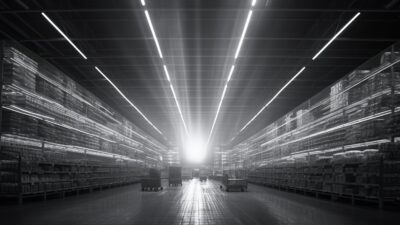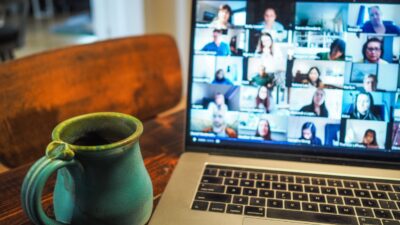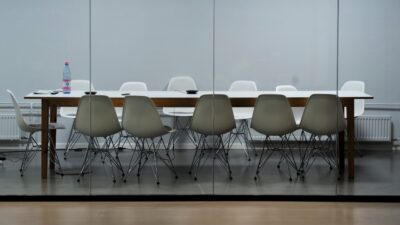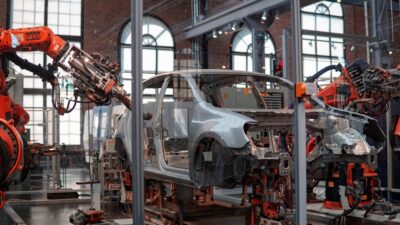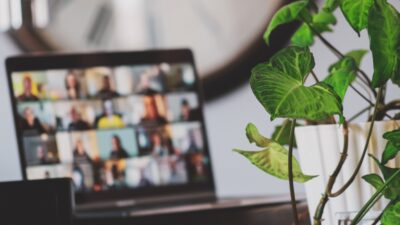Sandra Peter and Kai Riemer
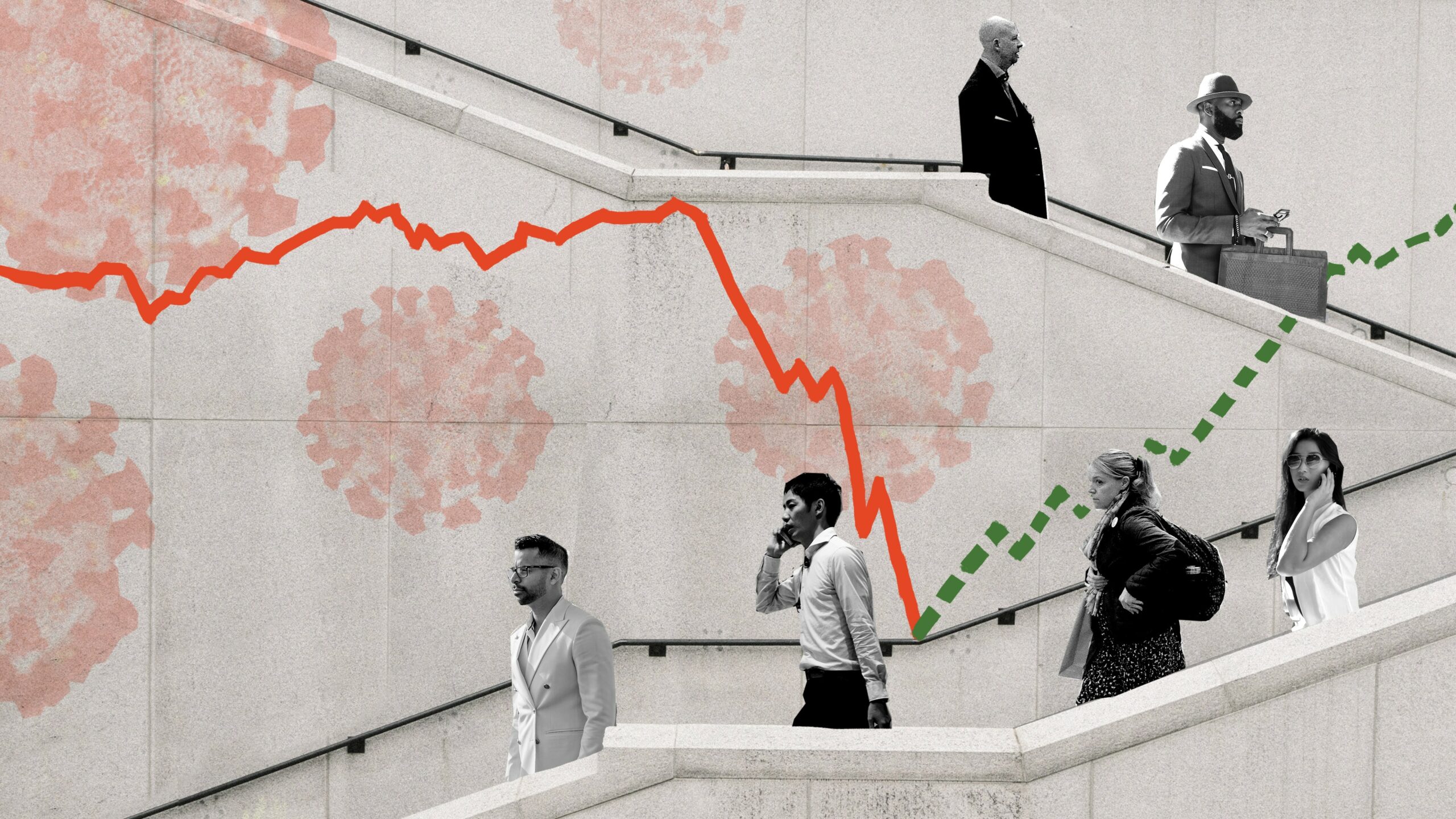
Commuting on Corona Business Insights
As societies slowly reopen, what does this mean for our daily commute? How commuting will change as we move beyond the lockdown.
As COVID-19 sets out to change the world forever, join Sandra Peter and Kai Riemer as they think about what’s to come in the future of business.
Shownotes
COVID-19’s temporary measures a long-term solution to road congestion
Public transport overhauled to cope with the return to work
Rider elasticity and rider demand
How will Americans commute after lockdowns end?
Commuting when public transport isn’t built for COVID-19
How your commute will change (a US perspective)
Paris to create 650kms of bike paths
Carmageddon on Sydney’s roads as we return to the office
Capacity slashed on Sydney’s public transport
Sydney-Melbourne is (or was) the world’s second busiest flight route
This episode is part of a podcast series covering what COVID-19 will mean for the business world, where we look at the impact on the economy, businesses, industries, workers and society. This is part of our ongoing coverage of the impact of COVID-19 on the future of business.
Follow the show on Apple Podcasts, Spotify, Overcast, Google Podcasts, Pocket Casts or wherever you get your podcasts. You can follow Sydney Business Insights on Flipboard, LinkedIn, Twitter and WeChat to keep updated with our latest insights.
Send us your news ideas to sbi@sydney.edu.au.
Dr Sandra Peter is the Director of Sydney Executive Plus and Associate Professor at the University of Sydney Business School. Her research and practice focuses on engaging with the future in productive ways, and the impact of emerging technologies on business and society.
Kai Riemer is Professor of Information Technology and Organisation, and Director of Sydney Executive Plus at the University of Sydney Business School. Kai's research interest is in Disruptive Technologies, Enterprise Social Media, Virtual Work, Collaborative Technologies and the Philosophy of Technology.
Share
We believe in open and honest access to knowledge. We use a Creative Commons Attribution NoDerivatives licence for our articles and podcasts, so you can republish them for free, online or in print.
Transcript
This transcript is the product of an artificial intelligence - human collaboration. Any mistakes are the human's fault. (Just saying. Accurately yours, AI)
Intro From the University of Sydney Business School, this is Sydney Business Insights.
Sandra And this is Corona Business Insights. I'm Sandra Peter.
Kai And I'm Kai Riemer.
Sandra And with everything that's happening, it's quite hard to understand what COVID-19 will mean for the business world. So in this series, we've been looking at the economy, business, industry, government, at workers and society.
Kai And today we talk about commuting, what the COVID-19 pandemic might mean for your commute to work.
Sandra As the world is slowly coming out of this crisis, many places around the world are looking at getting people physically back to work. So many places have started to open up and the journey might not be as simple as it first seems. So we want to explore today what it will take to physically get us back to work.
Kai And it turns out that for many of us, for most of the time, that might mean to still stay at home and work from home, because as we have to observe social distancing on public transport, for example, the capacity of trains and buses, or ferries in this case, in Sydney even planes, will have to be reduced significantly, which makes it impossible for many people to actually get to work.
Sandra So I'm looking first at public transport, maintaining social distancing and still getting back on public transport poses some real difficulties. The Guardian, for instance, reports on what it would take on train lines in London to get back to work. These trains have a capacity of about 910 people, but in rush hour that reaches about twelve hundred people. Yet maintaining social distancing would mean that only about 124 people could be at the train at any one time. That is, public transport would operate at about 10 percent of capacity.
Kai In Sydney on a normal day pre-pandemic, about 2 million commuters would be taken. That has been down to 20 percent or about 400000 during the two months of the coronavirus lockdown. And as the country opens up slowly in the next few weeks, this will likely have to increase to get people to the office. But it might not be possible because under the current recommendations, there will only be 12 people allowed on a bus or 32 on a typical train carriage, which means that trains will run at 24 per cent capacity and buses as low as 14 percent. Which means that for many of us we will not be able to take public transport and get into the city because train stations might have to close, once they get overcrowded, people will not get back on the train. And even if you will, for example, live far outside the city, you get on the train in the morning because you are living near the first stop. You might not get back in the evening. So many people will rethink the way in which they commute, might get into a car or might stay home instead.
Sandra And there is, of course, compounding mechanisms to this. We know from academic literature that if we have fewer capacity on transport or fewer rides scheduled, people change their behaviour and ridership on public transport goes down. And as you mentioned, these people might stay home, or alternatively, either get into a car or if they have the opportunity, bike or walk to work.
Kai Which sets up an interesting conundrum, two opposing forces that both will put pressure on the road network. And The Sydney Morning Herald has termed this 'Carmageddon', because on the one hand, people will want to take the car because they avoid mass transit. But on the other hand, the city of Sydney, for example, and indeed many cities around the world, Barcelona, Milan, Paris, London, they all make room for bikes and pedestrians so that people are moving about the city, the city centres, can socially distance. They want to encourage less cars on the road, more people on bikes. So a lot of traffic cones are being set up to create makeshift bike lanes. Many European cities are thinking about making those permanent, using the crisis to crowd out cars. So as more people flock to cars, there will be less space on many roads for those cars.
Sandra Let's not forget, there is a number of things pushing people towards getting into their cars, and it's not just safety, but it's also the fact that oil prices have been quite low. We've discussed this in another episode of Corona Business Insights, that that might entice people to turn to their cars as it is becoming cheaper to drive those cars.
Kai And in Sydney, the government is thinking about creating thousands more car park spaces, makeshift car park spaces. Companies are offering very low all-day parking to make it feasible for people to take the car and leave their car in the city centre. So while there's all these incentives to get into the car, the biggest disincentive will be traffic jams, will be the total commute time, which might indeed resemble some sort of Carmageddon. And we do know from studies that people don't mind a certain commute time. The ideal commute time is actually not zero. So under normal conditions, people like a little bit of distance between work and home, about 15 minutes to about 45 minutes. But once those commutes blow out to an hour, an hour and a half in the car, people will think twice about taking the car to work.
Sandra So really what we have here at the moment is quite a divergent picture for what the commute might look like post this pandemic. On the one hand, we have all these pilot studies in which the cities are closing streets to vehicles and giving it back to pedestrians or to people on bicycles. And on the other hand, there is good research that shows that there is an increased attractiveness of the car, and that as bio-security continues to be an increasing concern, congestion, which will be much worse than before the pandemic. And we'll include links here to a recent study by the Institute of Transport and Logistics at the University of Sydney looking into this very topic.
Kai And before we look forward to what this means for the next little while, as you mentioned, pilot. I want to bring up planes here because Australia is one of those countries where a considerable number of people actually commute between our biggest cities, Melbourne and Sydney. And this one is actually the second busiest air traffic route in the world with more than 54000 flights per year, which, you know, on my own rough calculation means that it's at least 150 per day, considering every day, so probably likely more on workdays more than 10 per hour, which means that in peak there'll be a plane between those two cities every five minutes or less. So that is a sizeable capacity of people travelling between those two cities on a daily basis, which again, under social distancing measures will not be possible, neither on the planes nor in the airports. So that's another group of people that will likely not commute in the way they did before. They might need to consider alternative work, move houses, move states, or indeed work from home.
Sandra So with these opposing forces and this divergent picture in mind, what does the pathway forward look like? Because there are some considerations for the very immediate future as we transition out of the pandemic, they might have to do with what our commute looks like.
Kai So we've seen around the world different things being implemented. In China, there's temperature checks when you walk in to train stations, there'll be designated walkways, so one-way walking around train stations so that people don't come in contact that much. Hand-washing station, sanitizing stations, much more cleaning of trains.
Sandra The return of the window that opens.
Kai Yeah, the return of the window that opens on the train. Less air conditioning, maybe plastic screens will be installed on seats to distance people and provide a little bit more protection. So all these things are likely to come in in the coming weeks and months.
Sandra But as we look forward longer term, there are a number of possible solutions that are starting to emerge as ways in which we can navigate the recovery better. And again, a shout out to our colleagues, Matt Beck and David Hensher, who have been doing a lot of research in this area, and we'll include a link to the study in the shownotes, where they suggest a number of policy and organisational responses that could alleviate the stress on the commute back to work.
Kai And one of them is quite simple, which is that people will need to continue to work from home. If we look at the recommended capacity on trains and buses, as low as 10 to 20 per cent, that means that most people will only be able to go to the office maybe a day a week, or two, because the capacity doesn't really afford it or they have to get into their cars, which means roads will be congested. So there's a lot of incentives for people to just keep working from home.
Sandra The other is that of peak-spreading, that is staggering the commuting hours, so we have those less dramatic peaks that we normally see in the morning and when work finishes. Although flattening that curve might also require interventions or a careful mix of legislation and things being left to us to decide on our own.
Kai Yeah, and to organisations, of course, because work patterns will need to change as people are not in the office or available at the same time, they might commute at different times. Some people very early in the morning, some people more around lunchtime. The core times at which, you know, meetings might be held where everyone is available might have to fall in line with those different travel patterns. So a lot more flexibilization in the way in which we work and organise our teamwork.
Sandra And last but not least, we should all be encouraging active transport in as much as possible, walking, cycling. We know that beyond the immediate risk reduction in the transmission of COVID-19, actually walking and cycling do have significant health benefits, including mental health benefits for those who engage in them.
Kai And that is, of course, studies that show that the more people spend time in cars, statistically obesity rates go up. So biking is a good thing. But again, it needs careful consideration and organising. We know from European cities like Münster, where I lived for more than 10 years, that when many, many people take their bikes, things can be quite crowded. So there, for example, bike lanes have the right of way. So they've tried to move bikes on because as bikes congregate at traffic lights and huddle around, social distancing can't be observed. So putting more people on bikes comes with its own challenges in social distancing as well.
Sandra It remains to be seen where to next, because up until now there was widespread consensus on how to move forward. What we should do, what the restrictions should look like. There is much less agreement on what a good way forward will be, and that will take a lot more coordinated actions from us, from organisations and from government.
Kai And this is where we want to leave you today and we'll make sure to include all the materials, as always, in the shownotes.
Sandra Until next time, this was Corona Business Insights.
Kai Thanks for listening.
Sandra Thanks for listening.
Outro From the University of Sydney Business School, this is Sydney Business Insights, the podcast that explores the future of business.
Close transcript
